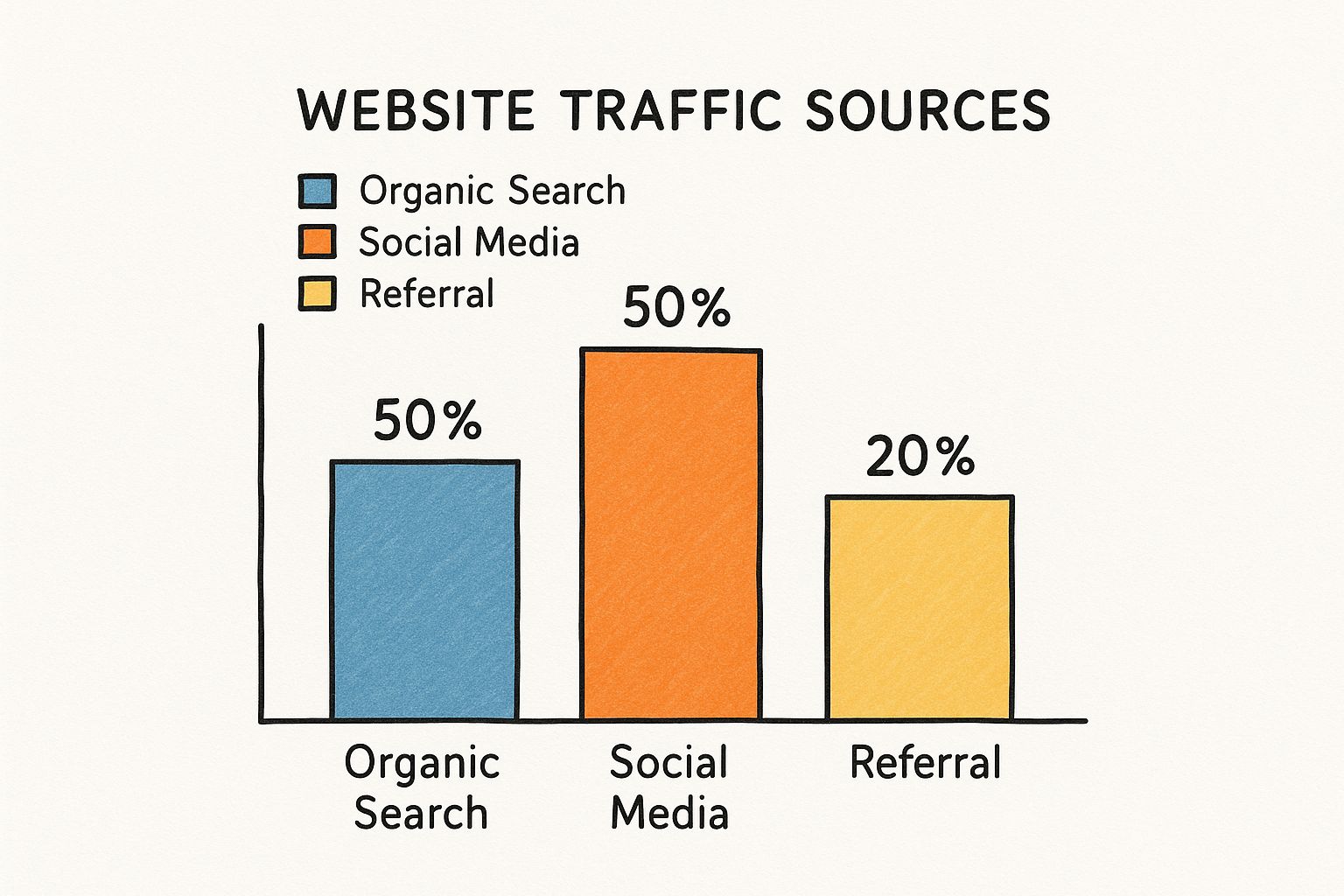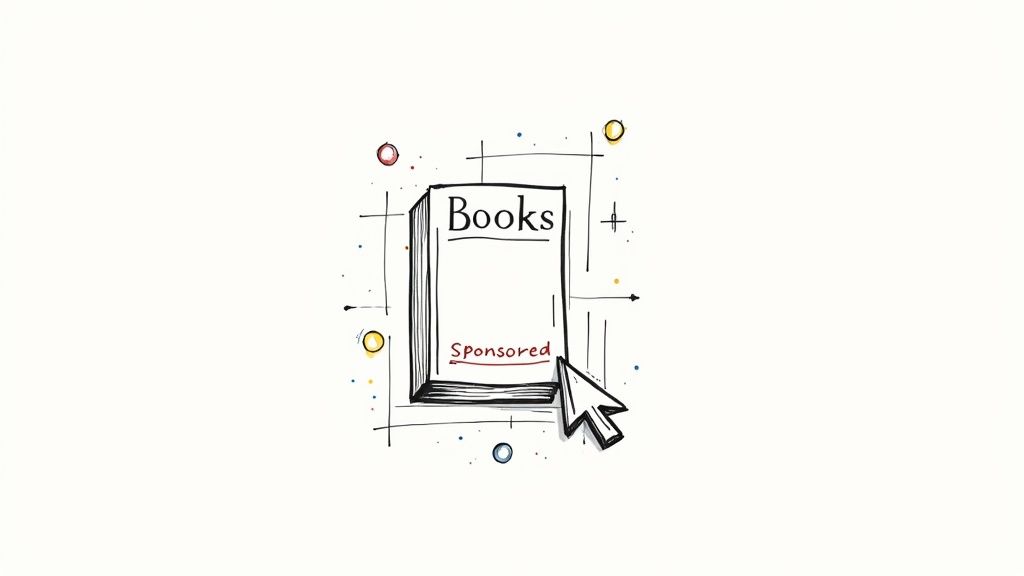How to Advertise Your Book: Proven Tips for Success

Advertising your book isn't a single action; it's a process that weaves together your author platform with smart, paid campaigns. The secret sauce is building a solid foundation first—think an author website and an email list—then using tools like Amazon and social media ads to pull in new readers.
Build Your Author Platform Before You Spend on Ads

I can't stress this enough: before you pour a single dollar into ads, you have to build your author platform. Think of it like this—you wouldn't throw a housewarming party before you've built the house. Without that foundation, any traffic you pay for will just show up to an empty lot, and your money will be wasted.
Your platform is your own slice of the internet, the hub where readers can find you, get to know your work, and eventually become dedicated fans. It’s what turns shouting into the void into having a real conversation with people who actually want to hear from you.
So, what does this foundation look like? It really comes down to three key pieces:
- A professional author website
- An active email list
- A focused social media presence
Set Up a Professional Author Website
Your author website is the anchor for everything you do online. It's more than just a digital business card; it’s the one place you have complete control, safe from the constantly shifting algorithms of social media. When someone discovers you through an ad or a podcast, they need a central place to land.
A great author site should be clean, professional, and dead simple to navigate. It needs to tell visitors exactly who you are, what kind of books you write, and—most importantly—where they can buy them.
At a minimum, you’ll want a homepage featuring your newest book, an "About" page to connect with readers, and a "Books" page with links to all the major retailers. And make sure a sign-up form for your email list is front and center.
Grow and Nurture an Email List
If your website is your home, your email list is your direct line to your biggest fans. I’m not exaggerating when I say it’s the single most powerful marketing tool you have. Unlike a social media follower, an email subscriber has personally invited you into their inbox.
The best way to get started is with a "reader magnet." This is something valuable you offer for free in exchange for an email address. It could be anything from a short prequel story or a deleted scene to a character art collection. Get creative!
A Quick Tip from Experience: The goal isn't just to hoard email addresses. It's to build genuine relationships. Send out newsletters that do more than just scream "buy my book!" Share a peek behind the curtain of your writing process, talk about other books you're loving, or offer exclusive content. This is how you build trust and turn casual readers into true evangelists for your work.
Establish a Meaningful Social Media Presence
Social media is where you build your community and engage with readers in real time. The key word here is strategic. Please, don't try to be on every single platform. It’s a recipe for burnout. Instead, figure out where your target readers hang out and go there.
For authors needing a little extra help with their promotional strategy, exploring affordable book marketing services can be a game-changer.
Here are a few examples I've seen work well:
- Thriller and mystery authors often connect with readers on Facebook and X (formerly Twitter).
- Romance and YA authors have found massive success on Instagram and TikTok (thanks, #BookTok!).
- Non-fiction authors can build serious credibility on platforms like LinkedIn and X.
Focus on creating content that offers value and sparks conversation. Instead of just dropping links to your book, share interesting excerpts, ask your followers questions, and jump into conversations with other authors and readers in your genre. That authentic engagement is what builds a following that will be eager to hear from you when you’re ready to advertise your book.
Mastering Amazon Ads to Drive Book Sales
Once your author platform is humming along, it's time to shift your focus to the single biggest marketplace for books: Amazon. If there's one lever you can pull to generate consistent, long-term sales, it's learning how to advertise effectively on this platform. This is where the real battle for reader visibility is won or lost.
Think of Amazon as a sprawling, digital city. Millions of readers are wandering its streets every single day, actively searching for their next great read. Running Amazon Ads is like putting up a giant, flashing billboard right in the middle of Times Square, pointing a massive arrow directly at your book. Without it, you’re just another book on a quiet side street, hoping someone happens to wander by.
Understanding the Main Amazon Ad Types
Amazon gives you a few different ad formats, but for most authors, the game plan revolves around two powerful options: Sponsored Products and Sponsored Brands. Each one has a specific job to do in your overall marketing strategy.
Sponsored Products are the absolute workhorses of your ad account. These are the ads you see sprinkled within the search results and popping up on the product pages of other books. They're tied to a single book (your ASIN) and are incredibly good at getting your book in front of readers at the exact moment they're looking for something just like it.
Sponsored Brands, on the other hand, are more like a big, beautiful banner at the top of a storefront. You'll see these ads sitting right at the top of the search results, usually featuring an author's logo, a custom headline, and up to three of their books. They are perfect for authors with a series or a decent backlist, as they help build that all-important brand recognition and can send shoppers to a dedicated Amazon Store page.
A classic mistake I see is a new author with just one book pouring their budget into a Sponsored Brand ad. Don't do that. Start with Sponsored Products to prove your cover, blurb, and keywords are actually working. Once you have a book that sells consistently, then you can use Sponsored Brands to showcase the whole series and boost that read-through rate.
The Science of Keyword and Product Targeting
Profitable ad campaigns are built on data, not guesswork. Success comes down to showing your ad to the right people, and that means getting your targeting dialed in. This is probably the most critical part of figuring out how to advertise your book on Amazon.
You’ve got two main ways to target shoppers:
- Keyword Targeting: This lets you bid on the specific words and phrases readers are typing into the search bar. We're talking about things like "fast-paced sci-fi thriller" or even the name of a famous author in your genre, such as "books by Lee Child."
- Product Targeting (ASIN/Category): This is a bit more direct. It lets you place your ad right on the product pages of other, similar books. It’s like setting up a small display for your fantasy novel right next to the current bestseller in the epic fantasy category.
A smart, balanced strategy uses both. Keyword targeting helps you capture readers who are actively searching, while product targeting lets you ethically "steal" readers right from your direct competitors.
Crafting Ad Copy That Actually Converts
You only get about 150 characters for your ad copy. That's it. It has to be a powerful sales pitch that can stop a reader mid-scroll and make them curious. Don't just rehash your book's blurb; pull out the single most compelling hook you have.
Try a few of these angles:
- Ask a question: "What if the monster under your bed was real?"
- Lean into a popular trope: "An enemies-to-lovers romance with a magical twist."
- Flash some social proof: "The twisty thriller readers are calling 'unputdownable'."
Always be testing different versions of your copy. You’d be amazed at how a small change in wording can have a huge impact on your click-through rate (CTR).
Setting a Realistic Budget and Bidding Strategy
You don't need a massive budget to get started. Seriously. Begin with a daily budget you're comfortable losing, even if it's just $5-$10 per day. In the beginning, your goal isn't to sell thousands of books; it's to gather precious data.
The key metric you'll live and die by is your Advertising Cost of Sale (ACoS). This simple number tells you how much you're spending on ads for every dollar of royalty you earn. For a much deeper dive into optimizing your ad spend, you might want to check out a comprehensive guide to Amazon PPC marketing which covers more advanced strategies.
At first, your ACoS will probably be high. That’s normal, so don't panic. As you let the campaigns run, you'll start to see which keywords and targets are actually making you money and which ones are just burning cash. From there, it's a process of refinement: you increase bids on what's working and add the wasteful search terms to a "negative keywords" list. This ongoing optimization is how you turn your Amazon Ads from a money pit into a true sales engine.
Using Social Media Ads to Discover New Readers
Organic social media is great for talking to the fans you already have. But if you want to find new ones? That’s where paid ads come in. Think of social media advertising as your book's discovery engine, putting it right in front of thousands of potential readers who are practically guaranteed to love your work but just haven't heard of you yet.
Instead of just posting into the void and crossing your fingers, you're tapping into a sophisticated system designed to match your book with the right readers. This is how you really start to scale your marketing beyond your current followers.
Pinpointing Your Ideal Reader with Laser-Focused Targeting
The real power of social ads isn't just reach; it's precision. Platforms like Facebook and Instagram have an incredible amount of data you can use to build a ridiculously detailed profile of your perfect reader. You’re not just shouting into a crowd—you're whispering directly into the ear of someone who wants to hear from you.
When you build your ad campaigns, you can get incredibly specific.
- Demographics: This is the basic stuff—age, gender, location. If you’ve written a historical romance set in Scotland, you can target women aged 35-65 in the UK who read romance novels. Easy.
- Interests: Here’s where it gets fun. You can target people who have shown interest in authors who write like you (think Stephen King for horror or Sarah J. Maas for romantasy), specific genres like "epic fantasy," or even TV shows and movies in your niche.
- Behaviors: You can even target people based on their online shopping habits, what kind of phone they use, or whether they frequently engage with author pages in your genre.
For authors just starting out, this kind of targeting is a complete game-changer. If you're running ads on Facebook, taking the time to master Facebook Ads targeting options will make every dollar you spend work that much harder.
Creating Ad Creative That Stops the Scroll
Let’s be honest: people scroll through their feeds mindlessly. Your ad has maybe two seconds to grab their attention before they swipe past. A blurry cover or a big block of text just won't do it. Your ad has to be a thumb-stopper.
And increasingly, that means video. Global digital ad spending is on track to hit $700 billion by 2025, and video ads consistently outperform static images by a staggering 120%. With social media ads making up nearly 40% of that total pie, a simple image just isn't enough to compete anymore.
Here are a few ideas that work:
- Short-Form Video: A punchy, 15-second book trailer with dramatic music and a killer quote is perfect for Instagram Stories or TikTok.
- Carousel Ads: Let readers swipe through your book cover, a glowing 5-star review, and a compelling snippet from a chapter. It’s interactive and tells a bigger story.
- Animated Graphics (GIFs): Even something simple, like text fading in over your cover, adds a bit of motion that can catch the eye.
The chart below gives you a sense of where website traffic comes from for many authors. Notice how big of a slice social media takes up.

While organic search is a huge piece of the puzzle, social media drives a solid 30% of traffic. You simply can't afford to ignore it.
Social Media Ad Platform Comparison for Authors
Not all social platforms are the same, and where your readers hang out depends heavily on what you write. It’s crucial to spend your ad budget where your specific audience is already congregating.
Here is a quick breakdown of the major players to help you decide where to focus your efforts.
| Platform | Primary Audience | Best Ad Format for Books | Key Advantage |
|---|---|---|---|
| Readers 30+, diverse interests (thrillers, sci-fi, non-fiction) | Single Image or Carousel Ads | Unmatched interest targeting lets you find incredibly niche audiences. | |
| Visually-driven readers (Romance, YA, Fantasy) | Video Stories, Reels Ads, Carousels | Perfect for showcasing stunning book covers and cinematic trailers. | |
| TikTok | YA, Romance, and trope-heavy fiction readers | Short-form video ads (spark ads) | Direct access to the powerful #BookTok community and viral trends. |
| "Aspirational" non-fiction (cookbooks, self-help, DIY) | Static "Pins" and Video Pins | High purchase intent; users are actively looking for ideas and solutions. |
Choosing the right platform is the first step. The next is running smart campaigns, analyzing the results, and being ready to adjust your strategy.
I've personally seen thriller authors hit it big with Facebook Ads because of its older demographic and deep interest targeting. At the same time, I know YA fantasy and romance authors who are absolutely killing it on Instagram and TikTok, where a single viral video in the #BookTok community can launch a book into the stratosphere overnight. The lesson? Don't just follow the latest trend—follow your readers.
The key is to start small, test everything, and once you find what works for your book, double down on it. For more ideas that go beyond paid ads, our guide on https://manuscriptreport.com/blog/book-marketing-for-self-published-authors offers a ton of other strategies to get your book noticed.
Turning Your Email List into a Sales Engine

Let's be clear: an email list isn't just another marketing channel. Unlike your social media followers, who are subject to the whims of an ever-changing algorithm, your email subscribers are yours. You have a direct, unfiltered line to their inbox, making it the single most powerful asset you have for advertising your book.
This isn't about sending a one-off "my book is for sale!" blast and hoping for the best. It's about strategically turning your newsletter into a vibrant community hub that builds genuine excitement and drives sales long before your launch day.
Crafting an Irresistible Reader Magnet
First things first, you need to convince people to subscribe. A generic "sign up for updates" plea just doesn't cut it anymore. You need to offer something genuinely valuable for free in exchange for that coveted email address. This is what we call a reader magnet.
Your magnet should be a tantalizing taste of your work, something directly connected to your books that leaves them wanting more.
- A prequel short story: Introduce a fan-favorite character or reveal a crucial backstory that enriches your main series.
- An exclusive novella: Nothing says "I value my subscribers" like a complete, satisfying story that isn't available for purchase anywhere else.
- Deleted scenes or alternate endings: Give your readers a peek behind the curtain. Fans love seeing the "what ifs" of your creative process.
- Character art or world maps: For those of us writing fantasy and sci-fi, high-quality visuals can be an incredibly compelling freebie.
The goal is to provide something so good that a reader feels like they're getting an amazing deal just for signing up.
Building a Newsletter People Actually Want to Read
Getting subscribers is only half the battle. Now you have to keep them engaged. If your newsletter only shows up in their inbox when you want them to buy something, you’ll see your unsubscribe rate climb fast.
Your real mission is to deliver consistent value so that readers actually look forward to hearing from you.
Mix it up. Share personal stories about your writing struggles and triumphs. Reveal your new cover design to your list a week before anyone else sees it. Run a poll and let your readers help you name a new character or a quirky coffee shop in your next book.
Think of your newsletter as an exclusive club for your biggest fans. Give them inside access and content they can't get on your public social media feeds. This sense of community is what builds loyalty and gets people excited to click "buy" on launch day.
Of course, a healthy list is a powerful list. To make sure your emails are actually landing in inboxes, you need to practice good list hygiene. For a deep dive, check out a practical guide to email list cleaning to keep your deliverability and engagement high.
Automating Your Welcome and Promotion
One of the smartest things you can do is set up an automated email sequence. This is a pre-written series of emails that gets sent out automatically whenever someone new joins your list. It's like having a personal assistant working for you 24/7, turning casual sign-ups into loyal fans while you get back to writing.
A simple, effective welcome sequence might look something like this:
- Email 1 (Sent Immediately): Deliver the reader magnet and give them a warm, personal welcome.
- Email 2 (2 days later): Share a fun fact about yourself or your writing process. This helps build a human connection.
- Email 3 (4 days later): Gently introduce them to your most popular book or the first book in your main series. Hook them with a great review or a compelling question.
- Email 4 (7 days later): Offer a small incentive, like a discount on your backlist, or point them to other free stories or blog posts they might enjoy.
This automated system ensures every new reader gets a consistent, welcoming experience, guiding them from subscriber to supporter without you having to lift a finger for each one.
Amplify Your Reach with Strategic Partnerships

Paid ads can definitely move the needle, but some of the best promotion you’ll ever get isn’t bought—it’s earned. You don't have to shout about your book into the void. By building genuine connections with the right people, you can tap into their established audiences and gain a level of credibility that money just can't buy.
Think of it as moving beyond your own little corner of the internet. You’re creating powerful, long-term allies who are actually excited to share your work. That kind of social proof from a trusted voice can be far more persuasive than any ad you could ever run.
Finding the Right Partners in Your Niche
First things first: who do your ideal readers already trust for book recommendations? The goal isn't to blast a generic request to everyone with a "book" hashtag. You're looking for collaborators whose audience and vibe are a perfect match for your genre.
Start by making a focused list. And please, don't just chase follower counts; look for genuine engagement and a natural fit.
- Book Bloggers: Hunt down blogs that consistently review books in your specific subgenre. A thoughtful review on a small but dedicated "cozy mystery" blog will do a lot more for you than a quick mention on a massive, general-interest site.
- Bookstagrammers & BookTokers: Look for creators with a distinct aesthetic and voice that resonates with your book's tone. Are they known for cinematic Reels that make you feel the story, or for deep-dive, analytical reviews?
- Podcasters: Find podcasts that interview authors in your genre or host book club-style discussions. Being a guest on a podcast puts your voice, quite literally, directly in the ears of potential fans.
Crafting a Pitch They Can't Ignore
Okay, you've got your list. Now it’s time to reach out. Remember, these creators are swimming in requests. Your pitch needs to stand out by being personal, professional, and—most importantly—focused on what’s in it for them.
Generic, copy-pasted emails are the fastest way to get ignored. Show them you’ve actually done your homework. Mention a specific review you loved or a podcast episode that made you think. That small touch proves you see them as a respected peer, not just another rung on your promotional ladder.
Keep your pitch short and make their job ridiculously easy:
- Introduce yourself quickly: State your name and the title of your book.
- Explain why them: Connect the dots. Reference their work and explain why you believe your book is a perfect fit for their specific audience.
- Make a clear "ask": Are you offering a free review copy? Pitching yourself as a podcast guest? Don't be vague.
- Include all the goods: Attach a simple press kit with your book cover, blurb, author bio, and buy links.
The secret to a killer pitch is changing your mindset from "What can you do for me?" to "I've got a great story your audience will love." When you frame your book as valuable content for their platform, a request transforms into a mutually beneficial collaboration.
Tapping into Traditional Media and PR
Don't forget about the power of local media. Newspapers, regional magazines, and local radio stations are often on the lookout for interesting stories about people in their community. Guess what? A local author who just published a new book is a fantastic human-interest story.
Draft a simple, one-page press release. It's not as scary as it sounds. Just include the key facts: your book title, a killer one-sentence hook, a short blurb, your bio, and clear contact info.
This kind of proactive outreach is a huge part of learning how to get the word out for free. For a deeper dive into promotional strategies, you can explore more insights on how to promote your book.
As self-publishing grows, so does the market for tools that help authors with these very tasks. The book marketing tools sector, valued at around $2.5 billion in 2025, is expected to grow by about 15% annually until 2033. This boom shows just how crucial it is for authors to find effective ways to manage their own promotion. By mixing modern tools with good old-fashioned relationship-building, you can create a powerful network to support your entire author career.
Answering Your Top Book Advertising Questions
Once you start thinking about advertising your book, the questions come thick and fast. It's totally normal. I've pulled together the most common questions I hear from authors to give you some straight answers and help you get started with a bit more confidence.
Let's jump right in.
How Much Should I Spend on Book Ads When I Am Starting Out?
This is always the first question, and thankfully, the answer is pretty straightforward: start with a daily budget you are completely comfortable losing. Seriously. Your first goal isn't to get rich; it's to gather data.
Think of your first ad campaigns as a cheap education. A budget of $5 to $10 per day on a platform like Amazon Ads is the perfect place to start. It’s enough to get you the clicks and impressions you need to see what’s actually working, but not so much that a bad week will sink you.
Put that small budget on just one or two of your best-looking campaigns. Spreading it too thin is a classic rookie mistake. By focusing your spend, you get clean, clear data on which keywords and ad copy are actually catching a reader's eye. Once you find a combination that's profitable, that’s your green light to start scaling up.
What Is a Good ACoS for Amazon Ads?
Ah, ACoS. You’ll hear this term everywhere. It stands for Advertising Cost of Sale, and it's just the percentage of your royalty you spent on ads to get one sale. So, if you spend $1 on ads to make a $2 royalty, your ACoS is 50%.
But what’s a “good” ACoS? The honest answer is: it depends entirely on your goals.
The simplest rule for making a profit is to keep your ACoS below your royalty percentage. If your royalty rate is 60% for an ebook, any ACoS under 60% means you’re in the black for that sale.
But remember, profit isn’t always the immediate goal. If you're launching a new book or trying to hook readers on a series, you might be perfectly happy to run ads at a loss (say, a 100% ACoS) just to get that initial burst of sales, reviews, and momentum.
Do I Need to Advertise All My Books at Once?
It’s tempting to throw your whole catalog out there, but that’s a surefire way to dilute your budget and muddy your results. A much smarter play, especially if you have a series, is to focus almost all of your ad budget on the first book.
Think of Book 1 as the front door to your entire author brand. By funneling all your ad traffic to that single entry point, you create a clear path for new readers to discover you.
This approach is all about the long game. You might break even or even lose a little on advertising Book 1, but the real money is in the sell-through. A certain percentage of those readers will immediately buy Book 2, then Book 3, and on down the line—all without you spending another dime on ads. That’s how you build a real, sustainable career.
The book market is only getting bigger. It's projected to hit $142.72 billion globally in 2025, and online sales are set to explode from $24.31 billion in 2024 to $48.27 billion by 2034. You can dig into more of these fascinating book sales statistics on Newprint.com to see just how critical a sharp digital strategy is.
Feeling buried under all the marketing tasks? ManuscriptReport.com can generate a full book marketing report in about 10 minutes, giving you everything from ad copy and keywords to social media posts and blurbs. For a comprehensive comparison of budget-friendly promotion options beyond advertising, explore our guide to affordable book marketing services that covers 11 professional services for every budget. Spend more time writing and less time marketing by checking out https://manuscriptreport.com.
Related Articles

6 Essential Book Marketing Strategies for Romance Novels
Discover 6 proven strategies to market your romance novel effectively and boost sales.

7 Essential Book Giveaway Strategies to Build Loyalty
Discover 7 essential book giveaway strategies to boost reader loyalty and engagement.

The Ultimate Affordable Book Launch Checklist: 9 Essential Steps for 2025
Complete affordable book launch checklist for 2025. Follow 9 proven steps—from budget planning to post-launch—for indie and self-published authors. Launch successfully for under $500.